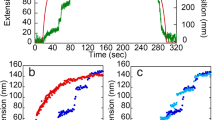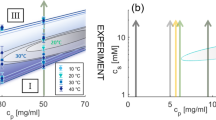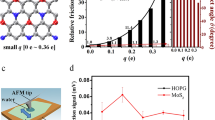Abstract
PROTEINS when spread upon aqueous solutions at sufficiently low surface concentrations exhibit the mechanical properties of two-dimensional liquids. A change of state occurs upon compression, the film acquiring marked rigidity in the plane of the surface; upon the slender basis of an analogy with the behaviour of proteins in bulk, the film in this rigid condition has been called a ‘gelâ1. A consequence of this rigidity is that whereas in the liquid film any change in pressure can be transmitted through a small aperture dividing the film into two portions, this should be no longer possible in the case of the solid film, and the presence of a constriction will result in an uneven distribution of pressures and surface concentrations. We have observed such effects in protein films divided by slits of various widths and have also noted in the liquid-solid transition region a phenomenon resembling thixotropy.
This is a preview of subscription content, access via your institution
Access options
Subscribe to this journal
Receive 51 print issues and online access
$199.00 per year
only $3.90 per issue
Buy this article
- Purchase on Springer Link
- Instant access to full article PDF
Prices may be subject to local taxes which are calculated during checkout
Similar content being viewed by others
References
Hughes and Rideal, Proc. Roy. Soc., A, 137, 70 (1932).
Author information
Authors and Affiliations
Rights and permissions
About this article
Cite this article
BATEMAN, J., CHAMBERS, L. Rigidity in Protein Films, and the Properties of the Force-Area Curves. Nature 142, 1158–1159 (1938). https://doi.org/10.1038/1421158c0
Issue Date:
DOI: https://doi.org/10.1038/1421158c0
Comments
By submitting a comment you agree to abide by our Terms and Community Guidelines. If you find something abusive or that does not comply with our terms or guidelines please flag it as inappropriate.



